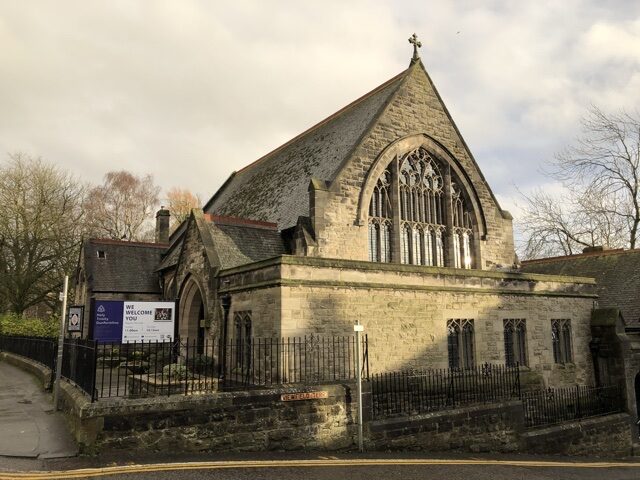Order of Service
The Welcome Team in the vestibule will be able to answer any questions you have and, at our main 11.00 am service on Sundays, will also give you a service sheet.
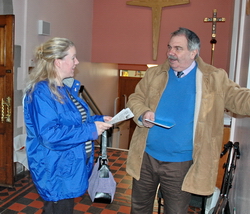
The service sheet has an outline of the order of service including page numbers which relate to the thin blue liturgy books (Scottish Liturgy, 1982) which you will find on the shelf in front of you. The service sheet also has details of the hymn numbers. You will find hymns in the green hymnbooks (NEH) or the purple hymnbooks (CG) both of which are on the shelf in front of you. We often follow the 1982 Scottish Liturgy which is provided as part of an Order of Service.
Sitting and standing
When to sit and stand can be a little confusing. As a general rule, the congregation stand to sing. This includes the hymns (though we remain seated for the Communion hymns, sung whilst people go forward to receive communion), and other parts of the service which are sung. We also stand at the beginning of the service for the entrance procession, for the reading from the Gospel, for the Peace, for the first part of the Eucharistic Prayer and at the end of the service as the choir and servers process out.
As a general rule, we sit or kneel for prayer.
For those unsure of when to sit or stand it might be helpful to sit far enough back in church to be able to see, and copy, what others do.
The Collection
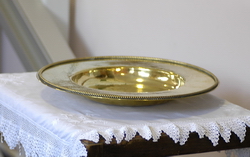
Normally we do not pass a plate around during the service (though we do at All-Age Services and one or two other big services). Instead, there is a plate either just by the doors into church, or a little way up the aisle inside the church and you are invited to leave your donations here. The plate is taken up to the altar and the money blessed later as part of the service. We also have contactless donations to pay by watch, card or phone.
Holy Communion
An important part of most of our services is Communion. At Holy Trinity we invite all people, to come forward to the communion rail to receive the body and blood of Christ.
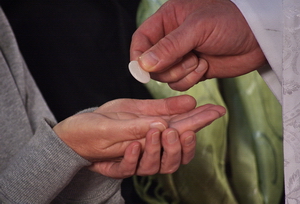
If you would rather not come forwards for communion, simply remain in your seat.
Observe/remain anonymous
If you don’t feel ready or able to actually take part in a service, you are welcome just to sit and watch. Likewise if you would prefer not to meet people and have a chat over coffee after the service, that’s fine too – simply turn right out of the church door, up the steps and out of the main door.
When you arrive

The main entrance of the church leads into a vestibule. Go round to the left and down the steps and you will be met by members of the welcome team who will give you an order of service (sample at this link) and answer any questions you might have. You will then be directed through the double doors and into the church itself. Please sit wherever you feel most comfortable. The two hymnbooks we use (New English Hymnal – green; Common Ground – purple) and the Blue 1982 Scottish Liturgy book will be on the shelf in front of you.
Once inside the church proper people tend to be quiet and to prepare themselves for the start of the service. Some people sit in silence, others kneel in prayer and some talk quietly to their neighbours. The organ will play quietly in the background.
As people come in to church, some will bow or genuflect in the direction of the altar at the front. Others don’t. This is a matter of personal preference and there is no need to do anything like that unless you would like to.
At the start of the service
The service starts when the choir and clergy process in from the back. They are led by a ‘crucifer’ who carries a cross. The choir follows (dressed in blue robes), then the server (dressed in a white alb) and then the clergy. The congregation stand for this procession.
When they get to the front, the choir, clergy and servers bow to the altar and take their places. One of the clergy faces the congregation, welcomes them and invites them to sit down.
Once the congregation are seated, one of the clergy makes any announcements that are necessary and we then stand to sing our first hymn
The first part of the service
This part of the service is called ‘The Preparation’ in the liturgy books. In it, we prepare ourselves to hear God’s Word and to meet him in Communion.
After the first hymn the congregation remain standing to say the opening prayers and responses which are in the blue liturgy book (the congregation say together the Collect for Purity and, thereafter, the words in bold). We then sit or kneel and say the Confession together, after which the priest proclaims our absolution, or forgiveness.
If it’s Lent or Advent we remain sitting or kneeling to sing the Kyrie and then go straight to the Collect (a short prayer for the day said by one of the clergy). Otherwise we miss out the Kyries and stand to sing the Gloria, an ancient hymn of praise, and remain standing for the Collect.
The Readings
After the Collect we enter into the part of the service known as the Liturgy of the Word.

We hear a reading from the Old Testament, we stand to sing a psalm, we hear a reading from the New Testament, sing a hymn and then remain standing for a reading from the Gospel. The Gospel reading is almost always read by one of the clergy standing at the top of the chancel steps (between the choir stalls). There is a sung response after the Gospel is announced and at the end of the Gospel Reading.
Following the readings, at the main 11.00 am service on Sundays, one of the clergy will preach a sermon – a short address lasting about 10 minutes in which the preacher helps us to make sense of the readings of the day and see their relevance to our lives.
The Creed
After the sermon, we stand to recite the Nicene Creed. This is one of the ancient creeds of the church formulated partly at the Council of Nicaea in 325 AD and finalised at the Council of Constantinople in 381 AD. We say it not so much to confirm our uncritical belief in all that it claims, but rather as an affirmation of both our heritage and history and of our commitment and loyalty to Christ.
Intercessions
Following the creed we sit or kneel for the Intercessions. These are our prayers for others. We pray, amongst other things, for those close to us, for those in positions of power and responsibility, for those who suffer or who are ill, and we remember those who have died and those who mourn their loss.
The prayers of intercession are normally led a different member of the congregation each week.
The Peace
In response to the priest’s invitation, “We meet in Christ’s name”, we say “Let us share His peace”, and then greet those around us with a handshake, a hug or a kiss, and wish each other “peace” or “peace be with you”.
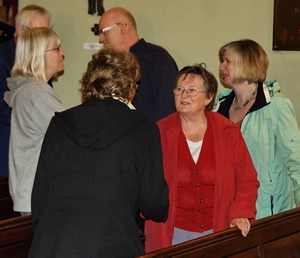
The Eucharistic Prayer
Following the Peace there is a hymn which we stand to sing and following that we remain standing for the Eucharistic prayer which is led by the priest, or celebrant as he or she is known. This is the prayer in which we thank God for his love, for his gift of life in Christ and in which the bread and wine are consecrated as Christ’s body and blood.

It begins with some sung responses and, after singing the “Holy, holy, holy” the congregation usually sit or kneel.
Communion
After the Eucharistic Prayer we sing the Lord’s Prayer and the “Lamb of God” and then the celebrant makes a general invitation to the congregation to come forward to the communion rail to receive communion. As explained above this is an important part of our tradition.
At the 11.00am service, the choir usually go first, then the congregation follow starting with those in the front pews with people further back in the church gradually following as those who went first return to their seats. Whilst people are receiving communion we sing, seated, the communion hymns.
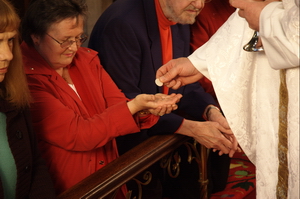
At the communion rail simply stand, hold out your hands to receive the ‘host’ (a thin circular wafer). If you do not want the sacrament you can still come forward for a blessing simply cross your arms. Once you have received the host, consume it immediately. Then if you wish to take the ‘wine’ move to the right and you will then be offered the chalice. If you do not just return to your seat.
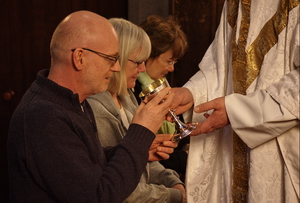
Either take it from the server and take a sip of wine (be aware, it is real, alcoholic wine – usually Port) or allow the server to put the chalice to your lips and take a sip as he tips it up. We do not allow the bread to be dipped into the chalice to stop contamination.
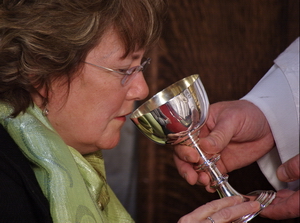
When you are ready, make your way back to your pew.
If you would rather not receive communion but would like a blessing, please go up to the communion rail but don’t put out your hands to receive the host in order to indicate to the priest that you would like a blessing. After you have received your blessing, and when you are ready, go back to your pew.
Of course, if you would rather remain in your pew and not go for communion or receive a blessing, that’s fine too – though you may have to let others sitting further in the pew out so they can go forwards.
After Communion
When everyone has received communion there is normally a short silence and then the celebrant will say a short prayer.
After this, one of the clergy will come to the front of the main body of the church and invite the children and young people forward and have a chat with them and ask what they’ve been doing in Young Church. This might not happen in school holidays.
After this, the celebrant says the remaining prayers, with responses from the congregation, blesses the congregation and we sing our final hymn.
As we sing the final hymn the choir, servers and clergy will process out – again being led out by the crucifer. The congregation remain standing until the procession has left the church.
The congregation then file out of the church, usually shaking hands with the clergy as they go. All members of the congregation are welcome to stay for coffee and refreshments in the hall.

